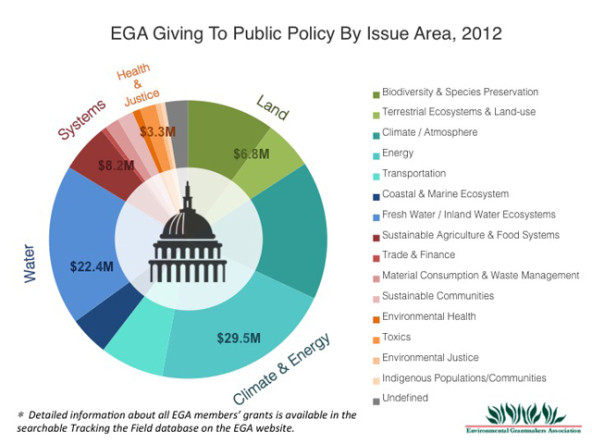There is new hope for sustaining people, place, and planet on Earth Day’s 45th anniversary, as burgeoning voices for equity, community, and faith are rising to the forefront of the environmental movement. Is the philanthropic community poised to invest in these arenas so that we can maximize this moment of opportunity?
Whether your starting place is economic justice or climate resilience, the solutions to these global challenges will require both philanthropy and the broader movement to move beyond specific silos and recognize the growing power of a multi-sector, boots-on-the ground approach.
Accordingly, Environmental Grantmakers Association (EGA) and Neighborhood Funders Group (NFG) find our paths increasingly intertwined. Building a sustainable and equitable future depends on how well we connect our work across issues and communities. To do that, we need to partner in new ways and challenge old assumptions.
One approach to successful collaborative partnering is to focus on places where communities are collectively taking on multiple, cross-cutting issues. Last fall, for example, NFG and EGA co-organized a funder learning tour on equity and sustainability in Puerto Rico, with a follow-up briefing last week with Philanthropy New York. This collaboration is bringing together funders from different sectors with different missions (democracy, climate, equity, conservation), but finding common ground in a special place. The trip highlighted community-based strategies for resilience focused on social, economic, and environmental justice.
Are you enjoying this article? Read more like this, plus SSIR's full archive of content, when you subscribe.
Puerto Rico is facing a major financial crisis, rising seas, and rising inequality, yet it often falls between the gaps of funding streams due to its geographic and political status (territory vs. state): National funders tend to overlook it as non-US, whereas international funders consider it domestic. Yet this small island is ripe with opportunity. Our tour helped us uncover one of Puerto Rico’s true strengths: a rich culture that has given birth to incredibly robust community infrastructure, including strong community-based organizations. And the work of these organizations is getting noticed in philanthropy: Open Society Foundations has listed Puerto Rico as one of its three priority “Open Places” sites and the Rockefeller Foundation includes the capital, San Juan, as one of 100 Resilient Cities.
Historically, environmental justice represents a small portion of the “green funder pie,” and when funding public policy, local and grassroots groups generally aren’t the ones who get the funding. In 2012, health and justice represented just 6 percent of EGA members grantmaking, with 84 percent of environmental justice grants going to organizations with budgets over $75,000. These new efforts in places where community is front and center represent a potential shift in that dynamic. The question is, will philanthropy-at-large catch the wave?

Shifting demographics across the United States continue to draw attention to natural allies for conservation and climate. As affinity groups representing grantmakers, we see that to forge a winning path forward, it is more critical than ever for philanthropy to prioritize community, equity, and diversity. At EGA’s recent Federal Policy Briefing, for example, we learned about the potential impact of the rising Latino electorate on domestic environmental policy beyond placed-based strategies. According to Matt Barreto, co-founder of Latino Decisions, polling shows that Latinos are an archetypal group of environmental champions—strong supporters of conservation, and in favor of government action on climate change. Latinos rank “combatting climate change” as their second most supported issue after immigration reform, with roughly 90 percent of those polled “in support.”
Many states that are facing major policy decisions around conservation and environmental issues (including Florida, California, Colorado, Nevada, and Pennsylvania) also happen to include large and growing Latino electorates. And there’s power in numbers. The size of the voting Latino electorate could grow to more than 13 million by 2016, representing a 34 percent increase from 2008.
New champions are also rising up from faith. This summer, the world is waiting for the Pope to address environmental issues in an encyclical letter that’s likely to include climate change. Carrying the weight of the Pope’s moral leadership and global influence, this letter could potentially plant the seeds of a fundamental shift in public opinion among people of faith and beyond.
To be successful in our efforts to protect our planet, we need to be proactive in engaging as many stakeholders as possible as allies. And these opportunities don’t end with the Latino or faith-based communities—there are exciting collaborations happening in education, arts, health, and beyond.
With environmental issues poised to retake the global spotlight around December’s 21st session of the Conference of the Parties (COP21) in Paris, we hope we can look back and see that not only did strategic collaborations and new voices help dramatically shift public opinion, but also funding streams flowed to places and alliances ripe for support and impact.
Support SSIR’s coverage of cross-sector solutions to global challenges.
Help us further the reach of innovative ideas. Donate today.
Read more stories by Dennis Quirin & Rachel Leon.

